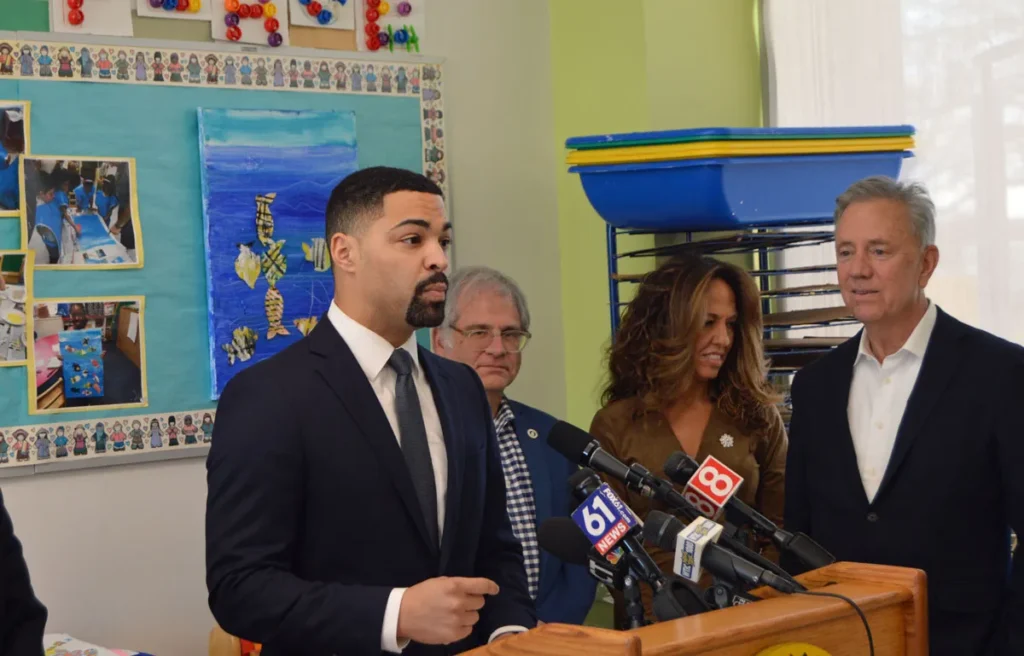Connecticut’s Baby Bonds Program Sees Strong Enrollment, Aims to Tackle Poverty

Audio By Carbonatix

Gov. Ned Lamont speaks at a press conference at The Bridge Family Center at Charter Oak International Academy in West Hartford on Wednesday, Jan. 17, 2024. Credit: Mike Savino, CTNewsJunkie
Gov. Ned Lamont and state Treasurer Erick Russell made the announcement about the Baby Bonds program at the Family Resource Center at Charter Oak International Academy in West Hartford.

Children listen as a classmate speaks at the Bridge Family Center’s Family Resource Center at Charter Oak International Academy in West Hartford on Wednesday, Jan. 17, 2024. Credit: Mike Savino, CTNewsJunkie
By Mike Savino, CTNewsJunkie.com
State Treasurer Erick Russell said 7,810 babies have already been enrolled in the state’s Baby Bonds program, a benefit state officials hope will put those children on a path to leaving poverty.
Enrolled babies have also been born in almost every town, a fact Russell and others said demonstrates the need statewide.
“The biggest indicator of someone’s ability to build wealth over time is having access to some capital,” he said during a press conference Wednesday at Charter Oak International Academy.
Since July 1, the state has set aside $3,200 for every baby eligible for Husky – the state’s Medicaid program – into a trust.
Beneficiaries can withdraw the money, including interest, between the ages of 18 and 30 for specific reasons, such as attending college, starting a business or buying a home.
“That will mean tens of thousands of potential homeowners and investors, entrepreneurs, educated and skilled workers in communities across the state,” Russell said.

State Treasurer Erick Russell talks about the state’s Baby Bonds program during a press conference Wednesday, Jan. 17, 2024, at The Bridge Family Center’s Family Resource Center at Charter Oak International Academy in West Hartford. Credit: Mike Savino, CTNewsJunkie
Russell said the enrollment figures are so far in line with his expectation of roughly 15,000 eligible babies born each year.
Department of Social Services Commissioner Andrea Barton Reeves said those children are spread throughout the state, though, in “an example of how widespread the need for Baby Bonds are in this state.”
The largest collections of eligible babies were in some of Connecticut’s biggest cities: 798 in Bridgeport, 621 in Hartford, 615 in Waterbury, 560 in New Haven and 376 in Stamford.
But Barton Reeves also noted towns like Ansonia had 75 enrolled babies, Bethel had 33, East Haven had 59, and Killingly had 44.
Proponents hope the program will help provide opportunities for children who are born into poverty in Connecticut. They also hope those opportunities will encourage them to stay and reinvest in their home state.
Charter Oak Principal Georgina Rivera recalled taking students on field trips to universities when she was a teacher.
When students would express doubt that they could afford to attend college, she would encourage them to succeed and seek scholarships. Rivera said the program levels the playing field.
“This bill is going to do something different,” Rivera said. “It’s going to change the lives of the students that it impacts right here in the state.”
Gov. Ned Lamont said the program fits in with broader efforts to help people avoid or eliminate their debt.
The state also recently launched Time-to-Own, a down-payment assistance program, and the current budget includes $6.5 million to purchase and eliminate patients’ medical debt.
“You want to build wealth in this society?” Lamont said. “Nothing more important than freeing yourself from debt and then ownership.”
Russell said the Baby Bonds program also provides education and resources aimed at helping families improve their financial situations.
That will eventually include access to financial literacy and workforce training for parents of eligible children, among other tools.
“Baby bonds, by itself, is not a silver bullet, it’s not going to solve all our problems,” he said.
Other states are looking at Connecticut’s model. Russell is scheduled to testify virtually Thursday in support of a similar proposal in Vermont. A task force in Massachusetts has also studied the idea.
Connecticut’s program has funding for 12 years thanks to a deal Russell struck with Lamont last spring.
Russell was able to free up $381 million placed into a reserve account when the state borrowed money to fund teachers’ pensions. That money eliminated the need to borrow funding, something Lamont opposed.
Russell and Lamont both expressed hope that they could find funding to keep the program going after the 12 years.
Russell said he has not secured any funding yet. Options could include grants, bonding or funding from the legislature to invest in the trust fund.
Like what you see here? Click here to subscribe to We-Ha’s newsletter so you’ll always be in the know about what’s happening in West Hartford! Click the blue button below to become a supporter of We-Ha.com and our efforts to continue producing quality journalism.



